![]()
![]()
![]()
Use LEFT and RIGHT arrow keys to navigate between flashcards;
Use UP and DOWN arrow keys to flip the card;
H to show hint;
A reads text to speech;
12 Cards in this Set
- Front
- Back

|
Geometric krater,
from the Diplyon cemetery, Athens, Greece ca. 740 BCE Metropolitan Museum of Art, New York GEOMETRIC PERIOD |
|

|
Mantiklos Apollo
statuette of a youth dedicated by Mantiklos to Apollo, from Thebes, Greece ca. 700-680 BCE Bronze Museum of Fine Arts, Boston ORIENTALIZING PERIOD |
|

|
New York Kouros
ca. 600 BCE Marble The sculptors of the earliest life-size statues of kouroi (young men) adopted the Egyptian pose for standing figures but the kouroi are nude and liberated from the original block of stone. Metropolitan Museum of Art, New York ARCHAIC PERIOD |
|

|
Kroisos from Anavysos, Greece
ca. 530 BCE Marble National Archaeological Museum, Athens ARCHAIC PERIOD This later kouros stood over the grave of Kroisos, a young man who died in battle. The statue displays increased naturalism in its proportions and more rounded modeling of face, torso, and limbs |
|

|
West Pediment, Temple of Artemis, Corfu, Greece
600 BCE, Limestone, Archaelogical Museum, Corfu ARCHAIC PERIOD The hideous Medusa and two panthers at the center of this early pediment serve as temple guardians. To either side and much smaller, are scenes from the Trojan War and the battle of Gods and Giants. |
|
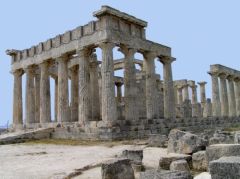
|
Temple of Athena Aphaia, Aegina
490-480 BCE ARCHAIC PERIOD In this refined early-fifth-century BCE Doric design, the columns are more slender and widely spaced, and there are only 6 columns on the facade and 12 on the flanks |
|

|
Gigantomachy, north frieze,
Siphnian Treasury, Delphi 530 BCE ARCHAIC PERIOD |
|
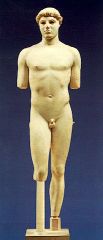
|
Kritios Boy
480 BCE CLASSICAL PERIOD This is the first statue to show how a person naturally stands. The sculptor depicted the shifting of weight from one leg to the other (contrapposto). The head turns slightly, and the Archaic smile is gone. |
|
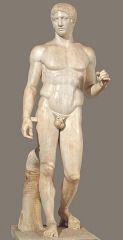
|
POLYKLEITOS,
Doyphoros (Spear Bearer) roman marble copy from Pompeii, Italy, after a bronze original CLASSICAL PERIOD Polykleitos sought to portry the perfect man and to impose order on human movement. He achieved his goals by employing harmonic proportions and a system of cross balance for all parts of the body. |
|
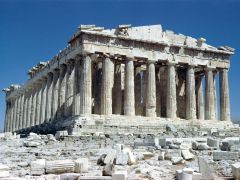
|
IKTINOS and KALLIKRATES
Parthenon (Temple of Athena, Parthenos), Acropolis, Athens, Greece CLASSICAL PERIOD The architects of the Parthenon believed that perfect beauty could be achieved by using harmonic proportions. Doric temple design 17 x 8 columns x = 2y + 1 |
|
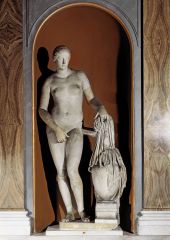
|
LATE CLASSICAL PERIOD
Praxiteles, Aphrodite of Knidos Roman marble copy of an Original of ca. 350-340 BCE, 6' 8" high Musei Vaticani, Rome The first nude statue of a goddess caused a sensation in the fourth century BCE. But Praxiteles was also famous to transform marble into soft and radiant flesh. His Aphrodite had "dewy eyes" |
|
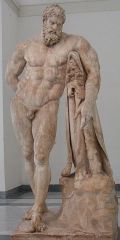
|
LATE CLASSICAL PERIOD
LYSSIPPOS, Weary Herakles (Farnese Herakles) Roman marble copy of bronze original Museo Archeologico Nazionale, Naples LYSIPPOS's portrayal of Herakles after the hero obtained the golden apples of the Hesperides ironically shows the mythological strong man as so weary that he must lean on his club for support |

